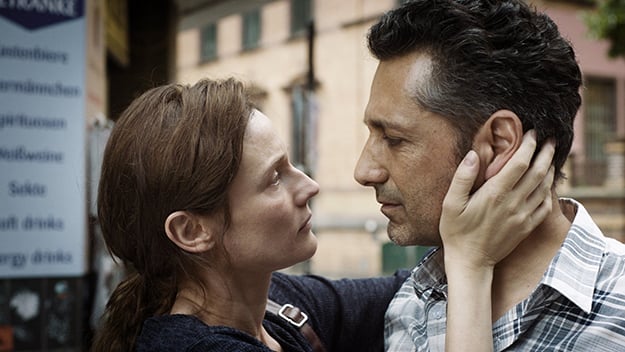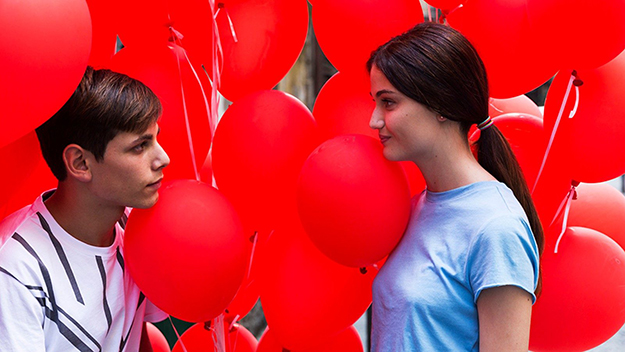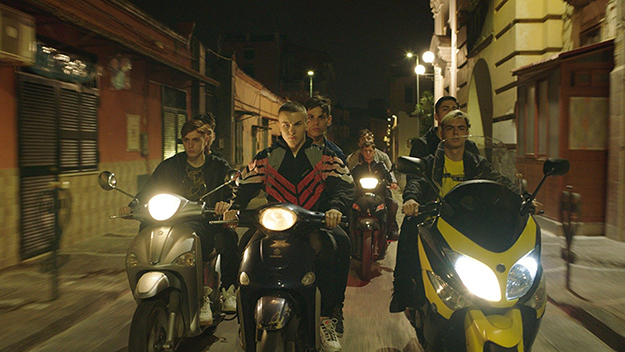Deep Focus: The Operative and Piranhas

The Operative (Yuval Adler, 2019)
Yuval Adler’s espionage drama, The Operative, and Claudio Giovannesi’s street-crime spectacle, Piranhas, would make an apt, moderately absorbing double-bill. These intelligent though uninspired genre movies streamline events that play out more lucidly and engrossingly in their celebrated fact-inspired source books about a female Mossad agent (Yiftach Reicher Atir’s The English Teacher) and a teenage Neapolitan gangster (Roberto Saviano’s The Piranhas: The Boy Bosses of Naples).
These films refresh timeworn “loss of innocence” themes. They also feel constricted, whether because of the logistical demands and compromises of multi-national filmmaking (The Operative) or a conventional approach to excessive, boundary-busting material (Piranhas).
What saves them is the High Docudrama aesthetic of the underlying material. Atir, a former IDF officer, calls his novel “a true story, of real-life operatives that are wholly made-up, and actual missions that never happened.” Saviano, in Piranhas, adopts a disclaimer from Francesco Rosi’s Hands Over the City: “The character and events that appear here are imaginary; what is authentic, on the other hand, is the social and environmental reality that produces them.”
After following the epic FX series The Americans through six compelling seasons that trace U.S.S.R. spies under deep cover in the U.S.A., I found it a relief for The Operative to center on a long-term covert operation that does not require the hero or heroine to seduce the enemy. Mossad handler Thomas (Martin Freeman) sends Rachel (Diane Kruger), our protagonist, a relatively untested agent and recent Israeli immigrant, on a mission to cripple Tehran’s nuclear program by inserting defective technology. When she tells Thomas that she has had sex with her target, Farhad Razavi (Cas Anvar), the head of an advanced electronics company, the spy-runner is appalled—partly because he’s developed a crush on her himself.
Israeli writer-director Adler made a potent debut with the tragic melodrama Bethlehem (2013). He maintained a harrowing, rigorous moral tension between a Shin Bet spy-handler and his key Palestinian informant, the kid brother of a most-wanted terrorist. In The Operative, Adler adroitly uses visual effects to meld footage taken inside Iran by a German cinematographer, with Adler directing by phone, to dramatic action shot on other locations and in studios. The director manages to evoke the other-ness and the friendliness of Tehran. We understand why Rachel opens up emotionally to her neighbors’ warmth and to Farhad’s generous, uninhibited sensuality.
Adler conveys the dislocating effects a secret identity and isolating work can have on a person as sensitive as Rachel. It’s hard to tell whether it’s more gut-wrenching when she gets up-close and personal with “collateral damage”—first as a reluctant witness, next as an executioner—or when she endures sexual assault under horrifying circumstances. Her tense charms peak when Rachel challenges Farhad with her independent wit. (Anvar projects the confidence that would attract an unmoored personality like Rachel.) As a performer, Kruger is superb at conveying muffled shock and modulated anxiety. Best of all, she honors her character’s secrets without resorting to mystique. Adler’s attentive, unshowy direction captures Rachel’s nuances and intensifies the film’s few visual surprises—Rachel’s entrance into a private retro-disco party with Farhad and his friends, complete with silver glitter-ball, or the green glow that bathes her in Razavi Electronics’ darkened computer room.

Still, that’s not enough to bring the film to a full boil. Adler has said that the novel’s detailed rendering of Mossad strategizing and spy-craft knocked him out, but he doesn’t get enough of it into the movie. Adler rarely provides a sense of how Rachel juggles teaching with her foreign trips or the work she does for Farhad’s company, editing the English documents he sends to Western partners.
The movie clumsily follows the book’s engrossing flashback structure: it begins when Rachel contacts Thomas years after he and she have left the agency. A guy named Joe (Johanon Herson), another veteran Mossadnik, interrogates Thomas to figure out why Rachel called him and then disappeared. The scenes between Joe and Thomas lack the crackle of parallel scenes in Atir’s book. Did the production require a performer as recognizable as Martin Freeman—Dr. Watson to Benedict Cumberbatch’s Sherlock, Martin Ross to Chadwick Boseman’s Black Panther—to secure its financing? Adler sensibly adjusts Rachel’s background to suit Kruger’s performance. But rewriting an Israeli named Ehud into a British Zionist named Thomas, based in Germany, adds too much distance between Rachel’s handler and the comrades skeptical of his leniency toward this roguish agent who has gone all-out rogue. Freeman can still be wonderful—he’s poignant and funny in his most pathetic/romantic moment, when Thomas comments to Rachel on her change of perfume. Too bad Freeman can’t strike up a rapport—or some sort of anti-rapport—with the other players.
And did the production partners demand that a majority of scenes be filmed in Germany and Bulgaria? That’s not necessarily a drawback, but the few scenes set in Israel feel rushed and perfunctory. In the end, the movie, like its heroine, comes off as an entity without a country.

Piranhas (Claudio Giovannesi, 2019)
The title Piranhas is an English attempt to convey the power and meaning of the Italian original, La paranza dei bambini, whose exact translation would be The Children’s Paranza. As Antony Shugaar wrote in a “Translator’s Note” at the end of the book, “A paranza is a procession of fishing vessels; it is also a mob crew, or a loose association of young men.” Roberto Saviano’s book chronicles the development of a mob made up of boys. It’s also about how gangsters and their fellow Neapolitans live in the same urban sea, “the sea of hard work, the sea of arrivals and departures, the sea of the sewer outlet, the sea that isolates you. There’s the sea of filth, the sea as an escape route, the sea as an insurmountable barrier. There’s the sea by night.” To follow his metaphor, the boys are both fishermen using bright lights to net a big catch, and fish, drawn by their own animal hungers into a dead-end existence.
Savione shares credit with the director and Maurizio Braucci on the script for Giovannesi’s movie. But this adaptation lacks the complex, gritty poetry of the one he and Braucci worked on for Matteo Garrone’s 2008 Gomorrah, based on the author’s previous “New Italian Epic.” It’s more like an episode of the smoothed-out Gomorrah TV series. Piranhas hews only to the bare outlines of 15-year-old Nicola (Francesco Di Napoli) gathering a child army in the Sanita neighborhood of Naples. Its wispiness is maddening. We rarely get a sense of the boy maintaining the pretense of a non-criminal life at home or at school. He and his friends are all about the swag—designer sneakers and name-brand sportswear.
The film simplifies all the supporting characters, including Nicola’s mother and girlfriend, and it blunts his own conflicts and extremes. Saviano’s book starts with an act of primal humiliation—Nicola literally shits on the face of a lad who had the temerity to “like” pictures that Nicola’s girlfriend posted on Facebook. (Of course, Nicola then posts the disgusting spectacle on Facebook.) By contrast, the movie begins as Nicola’s gang steals a towering Christmas tree from a deluxe open mall (a milder early anecdote from the book) then burns it in a bonfire as they parade shirtless around the blaze. Their pagan celebration is a striking yet familiar sight, carrying the unmistakable whiff of Lord of the Flies.

The movie adds a phony Robin Hood note to Nicola’s street education. Seeing his mother pay protection for her clothes-pressing shop to an outside mob motivates Nicola to form his own paranza. Yet Saviano’s journalistic vision and Giovannesi’s second-hand gangster-movie tropes gradually mesh in semi-gripping fashion. Filming Nicola and his buddies in lower Naples’ cramped stone fjords and ramshackle street marts, the director imparts a visceral sense of the Naples mob (or Camorra) circa 2016 as a volatile confederacy of mini-mobs. We see its tribal heritage degenerate from family ties to mere blood brotherhood—or as these kids might say, “blood bro’hood.” These young enlistees with trigger-fingers trained on video games move up and take charge as law enforcement rounds up their elders. Although Di Napoli plays Nicola with uninflected ardor, his thorough absorption in his role yields unexpected mysteries, especially when Nicola dons drag for his first execution. His baby-macho solidarity with his bros sets off homo-erotic vibes.
At its best, Piranhas suggests what William Wellman’s Public Enemy (1931) would have looked like if young Tom Powers (Frank Coghlan Jr.) had not grown up to be James Cagney. In a succession of archetypal scenes, Nicola and his pals learn about cutting hash and snorting coke instead of pushing booze, analyze which competitors, bosses, or mentors have feet of clay (and how to trip them up), and exult in their first firearms by shooting them atop a roof full of satellite dishes.
If only Giovannesi were as daring as the Wellman who had Cagney’s Tom Powers mash a grapefruit into his mistress’s face. This director gives short shrift to Nicola’s sadistic, Machiavellian manipulations, such as making a young woman think she’ll pay for her brother’s misbehavior by orally servicing each gang member.
“I ain’t so tough,” Tom Powers spit out after his rivals shot him into a gutter. We can say the same about this softened down, slicked up, rags-to-glad-rags movie.
Michael Sragow is a contributing editor to Film Comment and writes its Deep Focus column. He is a member of the National Society of Film Critics and the Los Angeles Film Critics Association.







